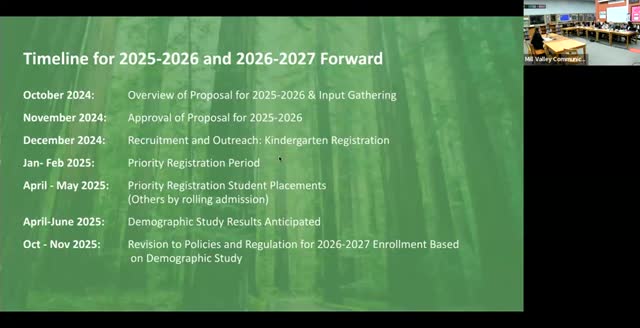Mill Valley School District explores new enrollment strategy amid parent concerns over school choice
October 10, 2024 | Mill Valley Elementary, School Districts, California
This article was created by AI summarizing key points discussed. AI makes mistakes, so for full details and context, please refer to the video of the full meeting. Please report any errors so we can fix them. Report an error »

In a recent Mill Valley School District Board meeting, the discussion centered around the complexities of school choice and enrollment patterns, revealing the emotional weight carried by families navigating these decisions. As board members gathered, the atmosphere was charged with a mix of hope and concern, particularly regarding the proximity of schools and the implications for community cohesion.
One of the key topics was the district's approach to school choice, which aims to allow families to select schools based on proximity to their homes. Board members acknowledged the challenges faced by families who feel displaced, often having to choose schools that are not their first preference. The conversation highlighted the painful reality for parents who repeatedly express their desire for their children to attend schools closer to home, a sentiment echoed by many in the community.
A board member raised a critical point about the need for clarity in defining what constitutes a "neighborhood school." The current ambiguity allows for varying interpretations among families, leading to requests for schools that may be far from their actual residences. This lack of definition complicates the enrollment process and raises questions about equity in access to education.
The board also discussed the importance of maintaining class sizes that foster effective learning environments. Concerns were voiced about the potential for significant disparities in class sizes across schools, which could arise from the new enrollment policies. The fear is that some schools may end up with overcrowded classrooms while others struggle to fill theirs, a situation that could undermine the quality of education provided.
As the meeting progressed, the board members recognized that the success of the proposed changes hinges on parents' willingness to choose their closest schools. This reliance on parental choice was seen as a significant variable, one that could either enhance or complicate the district's efforts to create a more equitable enrollment system.
In conclusion, the Mill Valley School District Board is grappling with the delicate balance of providing families with school choice while ensuring that the process is transparent and equitable. As they move forward, the board's decisions will not only impact enrollment patterns but also shape the community's educational landscape, making it essential for them to consider the voices and needs of all families involved.
One of the key topics was the district's approach to school choice, which aims to allow families to select schools based on proximity to their homes. Board members acknowledged the challenges faced by families who feel displaced, often having to choose schools that are not their first preference. The conversation highlighted the painful reality for parents who repeatedly express their desire for their children to attend schools closer to home, a sentiment echoed by many in the community.
A board member raised a critical point about the need for clarity in defining what constitutes a "neighborhood school." The current ambiguity allows for varying interpretations among families, leading to requests for schools that may be far from their actual residences. This lack of definition complicates the enrollment process and raises questions about equity in access to education.
The board also discussed the importance of maintaining class sizes that foster effective learning environments. Concerns were voiced about the potential for significant disparities in class sizes across schools, which could arise from the new enrollment policies. The fear is that some schools may end up with overcrowded classrooms while others struggle to fill theirs, a situation that could undermine the quality of education provided.
As the meeting progressed, the board members recognized that the success of the proposed changes hinges on parents' willingness to choose their closest schools. This reliance on parental choice was seen as a significant variable, one that could either enhance or complicate the district's efforts to create a more equitable enrollment system.
In conclusion, the Mill Valley School District Board is grappling with the delicate balance of providing families with school choice while ensuring that the process is transparent and equitable. As they move forward, the board's decisions will not only impact enrollment patterns but also shape the community's educational landscape, making it essential for them to consider the voices and needs of all families involved.
View full meeting
This article is based on a recent meeting—watch the full video and explore the complete transcript for deeper insights into the discussion.
View full meeting
